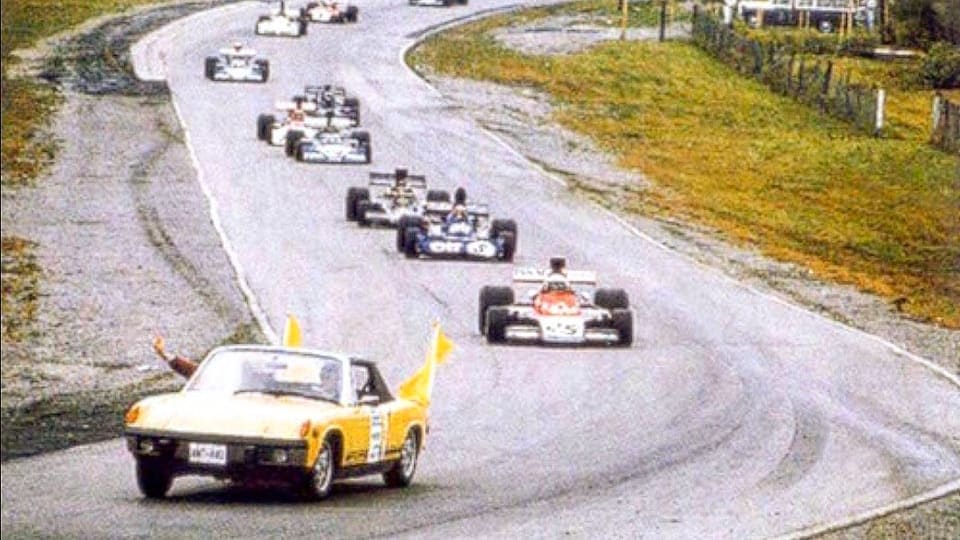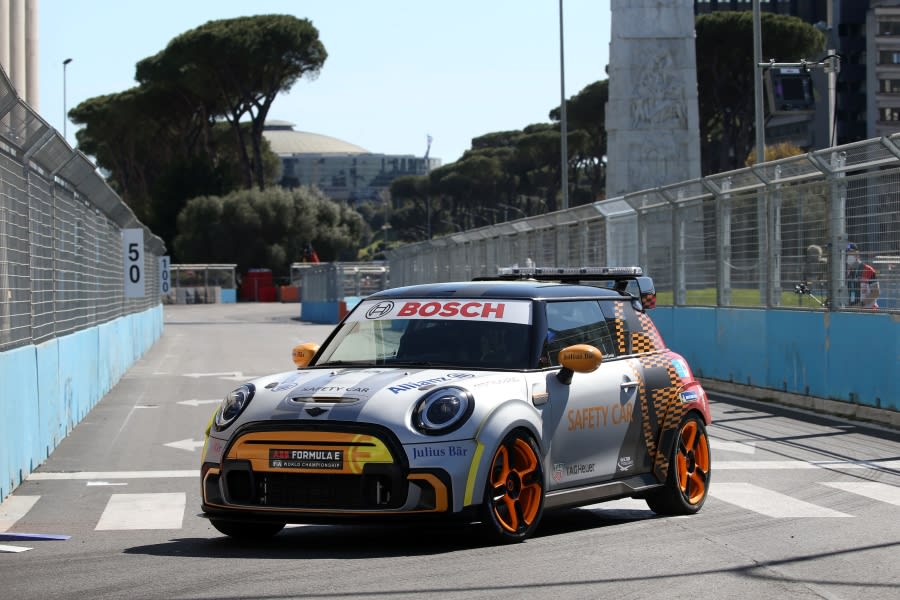Protests, fierce racing rivalries, and terrifying crashes - the British Grand Prix had the lot.

Formula 1 thundered into Silverstone at the weekend with more than 400,000 fans descending on the historic Northamptonshire racetrack.
Ferrari's Carlos Sainz took the chequered flag, beating team-mate Charles Leclerc to score his first Formula 1 win.
But that doesn't even tell half the story.
During the first lap - on the first corner - an almighty tangle between Alfa Romeo's Zhou Guanyu, AlphaTauri's Pierre Gasly and Mercedes' George Russell saw Zhou ending up on his roof and hurtling at speed towards the track fence.
The incident put both Zhou and Williams' Alex Albon into the medical centre, though any serious injuries were miraculously avoided.
Meanwhile, as the race was red flagged, a group of climate activist protestors also decided to invade the track and sit down on the famous Wellington Straight.
It's fair to say, then, that the official Formula One safety car - an Aston Martin Vantage - had plenty of work to do.

These safety cars - typically a modified version of a high-performance production car - do a really important job.
If there’s a crash that needs clearing, or if there’s an obstruction on the track - or simply hellish weather - the safety car will emerge from the pits to slow-down the pace of the racers for the duration of the ‘caution period’.
Once the danger is over, the safety car disappears and the race resumes.
In order to operate in these testing environments, official F1 safety cars need to be as agile as they are rapid.
And to celebrate these unsung heroes of Formula 1, here’s our pick of history’s best:
Porsche 914 (1973)

(Pic credit - Drive.com)
While official safety cars weren’t introduced until the 1990s, the plucky little Porsche 914 was deployed at the Canadian Grand Prix in 1973 when the heavens opened and turned the track into a paddling pool. While the 2.0 litre Porsche 914 was a trend-setting pioneer, things didn’t go entirely to plan.
The driver at the wheel of the Porsche actually latched-on to and led the wrong race leader, a mistake that wasn’t rectified until a day or two later.
Lamborghini Countach (1981-1983)

(Photo credit - Goodwood)
Like the Porsche 914 above, the Countach is also something of an unofficial safety car. It was waiting in the wings on standby at the Monaco Grand Prix in 1981, 1982 and 1983, but wasn’t actually deployed at all in race conditions.
With the Countach’s reputation for, erm, ‘spirited’ handling and a lack of visibility, perhaps that’s no bad thing…
Fiat Tempra (1993)

(Photo credit - Goodwood)
And so, this is it - the very first official outing for a Formula 1 safety car. Let’s set the scene - it’s 1993 and the racers have assembled for the Brazilian Grand Prix. But when inclement conditions arrive, the safety car that leads the pack is a… bog standard 2.0 Fiat Tempra 16V with a lowly power output of 125 PS. Driver Damon Hill was one of the many who looked-on with a smirk.
Renault Clio (1996)

(Photo credit - F1 Images)
Another humble car to make this list is the Renault Clio hatchback. A modified 1.8 litre, 140 hp Clio 16s was employed at the Argentine Grand Prix in 1996. And it proved so popular with fans that Renault produced a special, limited edition 2.0 litre ‘Clio Williams’ hot hatch to celebrate. You can expect to pay around £20,000 for a good example of a Clio Williams today.
Mercedes-AMG C 36 (1997)

By the late Nineties, F1 had struck a special deal with both Mercedes-Benz and Aston Martin to source its safety cars - and it’s a partnership that continues to this day.
The first Mercedes safety car to appear was the super-sleek C 36 AMG, which first arrived in the UK in 1994. With power of 280 bhp and a 0-60mph time of just 6.1 sec, the C 36 could properly keep the pace.
Mercedes SLS AMG GT (2012)

One of the best-looking safety cars ever seen in F1? In our eyes, it’s simply got to be. The Mercedes SLS AMG GT is a gorgeous grand tourer with power of 583bhp and 650 Nm of torque thanks to a huge 6.3-litre V8 engine. Legendary racing driver David Coulthard had a hand in making the SLS AMG GT a reality and became a champion of the car. And, tragically, the SLS AMG GT was called into action in 2014 in the wake of the death of Jules Bianchi, after he collided with a recovery vehicle at the Japanese Grand Prix.
Aston Martin Vantage (2021)

British firm Aston Martin scored a double-whammy in F1 in 2021. Not only did the Vantage become an official safety car, the DBX SUV was also installed as a bona fide ‘Medical Car’.
The road-going Vantage was treated to a few performance tweaks that took power to 535 PS, delivered by a 4.0-litre twin-turbo V8 capable of accelerating from 0-60mph in just 3.5 seconds. A unique front splitter for the safety car Vantage also created an extra 155.6 kg of downforce.
MINI Electric (2021)

Away from Formula 1, MINI Electric was announced as the official safety car for FIA Formula E - the championship for battery-powered cars - in 2021. The MINI Electric Pacesetter has power of 181 hp - the exact same as the production MINI Electric you can lease today - and can sprint from 0-62mph in 6.7 seconds.
Enjoyed this? Read our latest news:
- All-electric new Citroen e-C4 X set to launch
- New electric vehicle charging regulations explained
- New BMW M3 Competition Touring revealed
- New Hyundai Ioniq 6 ‘streamliner’ revealed
- Electric VW ID. Aero to get 385 mile range
Where To Next?
For all the latest reviews, advice and new car deals, sign up to our newsletter.
Looking for a great leasing deal? Check out our incredible range of special offers.
Read our latest reviews and find the right model for you.
Want to know more about leasing? Take a look at our comprehensive leasing guides.
Interested in everything motoring? Why not catch up on all the latest car leasing news.

















